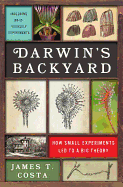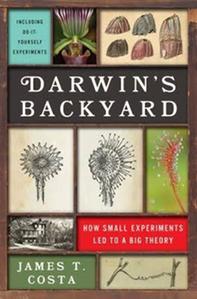
 Great scientists are often famous for one or two projects out of a lifetime of study. Charles Darwin is best known for the voyage of the Beagle, which he took in his 20s, and for his book On the Origin of Species. Biologist and author James T. Costa offers a more domestic view of Darwin's life and work in Darwin's Backyard, looking at his systematic explorations of the natural world in the context of his childhood and adult family life, his friends and neighbors and the larger scientific community of his day. At the end of each chapter, Costa provides Darwinesque experiments on seeds, plants, barnacles and earthworms, among other subjects.
Great scientists are often famous for one or two projects out of a lifetime of study. Charles Darwin is best known for the voyage of the Beagle, which he took in his 20s, and for his book On the Origin of Species. Biologist and author James T. Costa offers a more domestic view of Darwin's life and work in Darwin's Backyard, looking at his systematic explorations of the natural world in the context of his childhood and adult family life, his friends and neighbors and the larger scientific community of his day. At the end of each chapter, Costa provides Darwinesque experiments on seeds, plants, barnacles and earthworms, among other subjects.
Darwin comes across as a charmingly enthusiastic and curious character in this illustrated biography, which includes a college friend's early cartoon of him going beetle hunting, perched astride a giant beetle and waving a butterfly net. His work could make him antisocial, too, leading him to commandeer rooms and furniture for his often smelly and dirty collections, and to "dispatch" his daughter's cat when it ate his fancy pigeons. Overall, however, his family seems to have been tolerant and even enthusiastic about his studies. He graphed the searching behavior of vine tendrils, and studied the dietary preferences of sundew plants, feeding them with "drops of milk, egg white, raw meat infusion, saliva, mucus, nitrate of ammonia, even his own urine." He recruited his seven children to help him with many projects. They played music to worms, surveyed plant populations and tracked bees to their homes after Darwin made the insects more visible by tossing flour over them. A friend had a favorite anecdote about the time one of Darwin's sons was visiting. He "looked around and, seeing no microscope or dissecting equipment, asked of his friend's dad 'Then where does he do his barnacles?' For all the kids knew, everyone's dad worked on barnacles."
This is an unusual look at the daily creative life of a great scientist, with opportunities to dig in and observe the workings of nature first hand using methods very similar to his own. The reading level is high, but the experiments could be done by any sufficiently interested person over the age of 10, or modified by teachers. Costa provides clear instructions, supply lists, resources for unusual materials and suggestions for further reading. "Darwin's approaches were varied... rarely meeting modern standards of rigid experimental design. But for all that, Darwin managed to learn an awful lot about how the world works. And it all began in that smelly boyhood laboratory at the bottom of the garden." --Sara Catterall
Shelf Talker: This is a biography of Darwin's lesser known, lifelong studies of the natural world, with well-constructed sample experiments for readers to conduct themselves.

